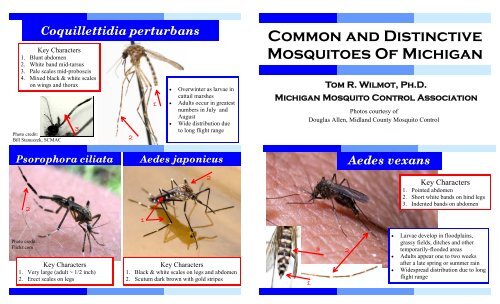Common and Distinctive Mosquitoes of Michigan
Common and Distinctive Mosquitoes of Michigan
Common and Distinctive Mosquitoes of Michigan
You also want an ePaper? Increase the reach of your titles
YUMPU automatically turns print PDFs into web optimized ePapers that Google loves.
Coquillettidia perturbans<br />
Key Characters<br />
1. Blunt abdomen<br />
2. White b<strong>and</strong> mid-tarsus<br />
3. Pale scales mid-proboscis<br />
4. Mixed black & white scales<br />
on wings <strong>and</strong> thorax<br />
Photo credit:<br />
Bill Stanuszek, SCMAC<br />
3<br />
2<br />
1<br />
• Overwinter as larvae in<br />
cattail marshes<br />
• Adults occur in greatest<br />
numbers in July <strong>and</strong><br />
August<br />
• Wide distribution due<br />
to long flight range<br />
<strong>Common</strong> <strong>and</strong> <strong>Distinctive</strong><br />
<strong>Mosquitoes</strong> Of <strong>Michigan</strong><br />
Tom R. Wilmot, Ph.D.<br />
<strong>Michigan</strong> Mosquito Control Association<br />
Photos courtesy <strong>of</strong><br />
Douglas Allen, Midl<strong>and</strong> County Mosquito Control<br />
Psorophora ciliata<br />
Aedes japonicus<br />
Aedes vexans<br />
2<br />
2<br />
Key Characters<br />
1. Pointed abdomen<br />
2. Short white b<strong>and</strong>s on hind legs<br />
3. Indented b<strong>and</strong>s on abdomen<br />
1<br />
Photo credit:<br />
Flickr.com<br />
Key Characters<br />
1. Very large (adult ~ 1/2 inch)<br />
2. Erect scales on legs<br />
Key Characters<br />
1. Black & white scales on legs <strong>and</strong> abdomen<br />
2. Scutum dark brown with gold stripes<br />
1<br />
3<br />
2<br />
• Larvae develop in floodplains,<br />
grassy fields, ditches <strong>and</strong> other<br />
temporarily-flooded areas<br />
• Adults appear one to two weeks<br />
after a late spring or summer rain<br />
• Widespread distribution due to long<br />
flight range
Key Characters<br />
1. Pointed abdomen<br />
2. White b<strong>and</strong>s on hind legs<br />
cross the joints<br />
Aedes canadensis<br />
1<br />
• Develop in vernal<br />
woodl<strong>and</strong> pools<br />
• Adults appear rather<br />
abruptly in spring <strong>and</strong><br />
last into early summer<br />
Anopheles punctipennis<br />
1<br />
Key Characters<br />
1. Black & white spots<br />
on wings<br />
2. Long palps<br />
3. Legs long <strong>and</strong> dark<br />
Related Species (together referred to as spring Aedes species)<br />
Aedes stimulans group - hind legs with long white basal b<strong>and</strong>s<br />
Aedes communis group - hind legs with dark scales<br />
2<br />
2<br />
Related Species<br />
Anopheles quadrimaculatus - Wings scales all dark<br />
• Overwinter as adults<br />
• Found in greatest<br />
numbers July through<br />
September<br />
• Develop in swamps,<br />
marshes <strong>and</strong> ditches<br />
3<br />
Aedes triseriatus<br />
4<br />
Key Characters<br />
1. Pointed abdomen<br />
2. Hind legs dark<br />
3. Distinct black & white scales<br />
on abdomen<br />
4. Scutum black with silvery<br />
scales laterally<br />
Culex pipiens<br />
1<br />
• Overwinter as adults<br />
• Found in greatest<br />
numbers from June<br />
through September<br />
• Often associated with<br />
containers <strong>and</strong> other<br />
man-made habitat<br />
• Adults occur from May<br />
through September<br />
• Day-biters found primarily<br />
in wooded areas / tire yards<br />
Related Species<br />
Culex restuans -<br />
Pale spots on scutum<br />
Photo credit:<br />
James Gathany, CDC<br />
Key Characters<br />
1. Blunt abdomen<br />
2. Pale brown/gold coloration






